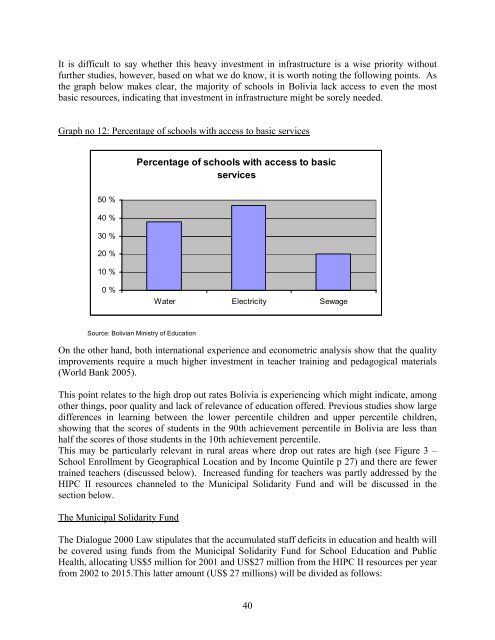Assessing the impact of PRSPs on Child Poverty: The Case of Bolivia
Assessing the impact of PRSPs on Child Poverty: The Case of Bolivia
Assessing the impact of PRSPs on Child Poverty: The Case of Bolivia
You also want an ePaper? Increase the reach of your titles
YUMPU automatically turns print PDFs into web optimized ePapers that Google loves.
It is difficult to say whe<str<strong>on</strong>g>the</str<strong>on</strong>g>r this heavy investment in infrastructure is a wise priority without<br />
fur<str<strong>on</strong>g>the</str<strong>on</strong>g>r studies, however, based <strong>on</strong> what we do know, it is worth noting <str<strong>on</strong>g>the</str<strong>on</strong>g> following points. As<br />
<str<strong>on</strong>g>the</str<strong>on</strong>g> graph below makes clear, <str<strong>on</strong>g>the</str<strong>on</strong>g> majority <str<strong>on</strong>g>of</str<strong>on</strong>g> schools in <strong>Bolivia</strong> lack access to even <str<strong>on</strong>g>the</str<strong>on</strong>g> most<br />
basic resources, indicating that investment in infrastructure might be sorely needed.<br />
Graph no 12: Percentage <str<strong>on</strong>g>of</str<strong>on</strong>g> schools with access to basic services<br />
50 %<br />
40 %<br />
30 %<br />
20 %<br />
10 %<br />
0 %<br />
Percentage <str<strong>on</strong>g>of</str<strong>on</strong>g> schools with access to basic<br />
services<br />
Source: <strong>Bolivia</strong>n Ministry <str<strong>on</strong>g>of</str<strong>on</strong>g> Educati<strong>on</strong><br />
Water Electricity Sewage<br />
On <str<strong>on</strong>g>the</str<strong>on</strong>g> o<str<strong>on</strong>g>the</str<strong>on</strong>g>r hand, both internati<strong>on</strong>al experience and ec<strong>on</strong>ometric analysis show that <str<strong>on</strong>g>the</str<strong>on</strong>g> quality<br />
improvements require a much higher investment in teacher training and pedagogical materials<br />
(World Bank 2005).<br />
This point relates to <str<strong>on</strong>g>the</str<strong>on</strong>g> high drop out rates <strong>Bolivia</strong> is experiencing which might indicate, am<strong>on</strong>g<br />
o<str<strong>on</strong>g>the</str<strong>on</strong>g>r things, poor quality and lack <str<strong>on</strong>g>of</str<strong>on</strong>g> relevance <str<strong>on</strong>g>of</str<strong>on</strong>g> educati<strong>on</strong> <str<strong>on</strong>g>of</str<strong>on</strong>g>fered. Previous studies show large<br />
differences in learning between <str<strong>on</strong>g>the</str<strong>on</strong>g> lower percentile children and upper percentile children,<br />
showing that <str<strong>on</strong>g>the</str<strong>on</strong>g> scores <str<strong>on</strong>g>of</str<strong>on</strong>g> students in <str<strong>on</strong>g>the</str<strong>on</strong>g> 90th achievement percentile in <strong>Bolivia</strong> are less than<br />
half <str<strong>on</strong>g>the</str<strong>on</strong>g> scores <str<strong>on</strong>g>of</str<strong>on</strong>g> those students in <str<strong>on</strong>g>the</str<strong>on</strong>g> 10th achievement percentile.<br />
This may be particularly relevant in rural areas where drop out rates are high (see Figure 3 –<br />
School Enrollment by Geographical Locati<strong>on</strong> and by Income Quintile p 27) and <str<strong>on</strong>g>the</str<strong>on</strong>g>re are fewer<br />
trained teachers (discussed below). Increased funding for teachers was partly addressed by <str<strong>on</strong>g>the</str<strong>on</strong>g><br />
HIPC II resources channeled to <str<strong>on</strong>g>the</str<strong>on</strong>g> Municipal Solidarity Fund and will be discussed in <str<strong>on</strong>g>the</str<strong>on</strong>g><br />
secti<strong>on</strong> below.<br />
<strong>The</strong> Municipal Solidarity Fund<br />
<strong>The</strong> Dialogue 2000 Law stipulates that <str<strong>on</strong>g>the</str<strong>on</strong>g> accumulated staff deficits in educati<strong>on</strong> and health will<br />
be covered using funds from <str<strong>on</strong>g>the</str<strong>on</strong>g> Municipal Solidarity Fund for School Educati<strong>on</strong> and Public<br />
Health, allocating US$5 milli<strong>on</strong> for 2001 and US$27 milli<strong>on</strong> from <str<strong>on</strong>g>the</str<strong>on</strong>g> HIPC II resources per year<br />
from 2002 to 2015.This latter amount (US$ 27 milli<strong>on</strong>s) will be divided as follows:<br />
40



